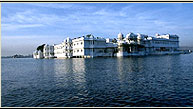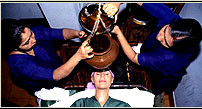-| Nasik | -
Location: District Nasik (Maharashtra) - Lat 19º 59'N, Long 73º
47'E

The group of twenty four caves are also known as Pandulena, was cut in a long
line in the north face of a hill about 8 kms. from Nasik, situated on an important
ancient trade route. The caves represent a brilliant phase in the rock cut Buddhist
architecture of the second century AD, as majority of the caves belong to this
time period. The two largest monastic establishments were built by the contemporary
Kings. The remaining caves were the gifts of the common people including monks
and a writer as per the inscribed evidences in the caves. The door frame of
chaitya griha cave no. 18 is embellished with likeness of the facade of the
chaitya griha with a vaunted roof and its jambs. The interior of Chaitya is
severely plain. On the either side of the chaitya griha is a monastery with
cave 17 and 20 forming part of one unified scheme. The monastery was probably
enlarged in 6th and 7th century AD. The embellishment of the facade of cave
no. 17 with pillars and pilaster bears a striking resemblance to the cave no.
10. The cave also underwent addition in the later period, when a relief of Lord
Buddha was carved on the back wall of the hall to the right of the door of the
back cell, which has a pillared portico in the front. Next to cave 20 but at
a lower level is cave 19,one of the earliest monasteries. Among the monasteries,
cave 3 and 10 have outshown others in size, planning and splendor on account
of their happy combination of the architectural grandeur and sculptural embellishment.
The monastery consists of a pillared veranda approached by a central flight
of steps, with a cell on either side and sixteen cells, each with a rock cut
bed, arranged on three sides of a spacious astylar hall. The chief beauty of
this cave lies in its dignified facade, effectively composed and carved. The
cave 3 is more ornamental and later version of cave 10.
Among the caves with relief of Buddha and Bodhisattvas, cave 23 consists of
irregular excavation of more than one unit, all now forming one complex with
full of partition walls containing the maximum number of such reliefs, including
one depicting the Maha Parinirvana and a number of female deities.




